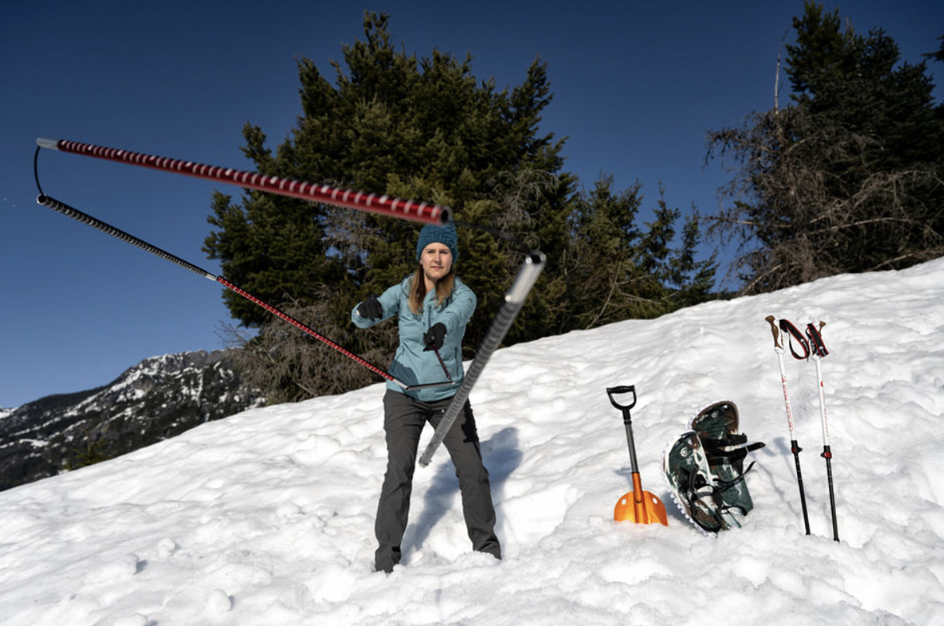Choosing the Right Avalanche Probe
An avalanche probe is a crucial tool for backcountry safety, helping rescuers locate and pinpoint buried victims in an avalanche. When selecting the proper probe, the most important factor to consider is the average depth of the snowpack in the areas where you ride or tour. A probe should be at least 240 cm to 300 cm (2.4 to 3 meters) in length, but longer probes (320 cm or more) are preferable in deep-snow regions. While longer probes add some weight, they provide better reach and efficiency when probing through avalanche debris.

Key Features of Avalanche Probes
Material and Construction
Avalanche probes are typically made from aluminum, carbon fiber, or steel, each offering different advantages:
Aluminum – The most common material, offering a balance of strength, durability, and affordability.
Carbon Fiber – Lighter than aluminum, making it ideal for weight-conscious ski mountaineers, but can be less durable in dense avalanche debris.
Steel – The strongest and most durable material, preferred by professional rescuers and guides, though it is heavier than other options.
Most probes are collapsible, consisting of multiple sections connected by an interior cable or tension cord, which allows for rapid deployment when needed.
Length
Probes come in a variety of lengths, typically ranging from 240 cm to 320 cm or more.
240-260 cm – Suitable for areas with a shallower snowpack or casual backcountry users.
280-300 cm – A good all-around length for most avalanche-prone regions.
320+ cm – Ideal for deep-snow locations or professional rescue operations.
A longer probe not only helps locate victims at greater depths but also makes probing more comfortable for extended periods.
Speed and Ease of Deployment
A good probe should be quick and easy to assemble. Most modern probes feature quick-locking mechanisms that allow them to be fully extended in just seconds. Common locking mechanisms include:
Pull-cord with a quick-lock system – A fast and reliable method using a tensioned cable inside the probe.
Snap or twist locks – Less common but still effective; however, they may take longer to secure.

Depth Markings
Many probes include depth markings along their length (e.g., in centimeters), allowing rescuers to estimate how deep a victim is buried. This helps in determining where to dig and how much snow needs to be moved to reach the person quickly.
Sturdiness and Performance in Compact Snow
Avalanche debris is often dense and compacted, making it difficult to penetrate. The best probes are stiff enough to push through hard snow without excessive bending. Steel and high-quality aluminum probes perform best in such conditions.
Portability and Weight
Since avalanche probes are carried in a backpack, they should be lightweight and compact when collapsed. Carbon fiber models are the lightest, while aluminum offers a good balance of weight and durability. Consider how much weight you're willing to carry based on the rest of your avalanche safety gear.
Compatibility with Other Avalanche Safety Gear
An avalanche probe should always be used in conjunction with an avalanche transceiver (beacon) and a shovel. The "beacon-probe-shovel" trio is essential for effective avalanche rescue.
How to Use an Avalanche Probe in a Rescue
Find the approximate location – Use an avalanche transceiver to locate the strongest signal.
Assemble your probe – Deploy the probe as quickly as possible using its tensioning system.
Start probing systematically – Insert the probe vertically at regular intervals (25 cm apart) in a spiral or grid pattern around the strongest transceiver signal.
Confirm a strike – A soft or resistant feel indicates you’ve contacted the victim. Mark the depth.
Begin digging – Start shoveling downhill from the victim to remove snow as efficiently as possible.
Training Tip: Regularly practice with your probe in real snow conditions to improve speed and efficiency during an emergency.

Best Avalanche Probes: Trusted Brands
Several manufacturers produce high-quality avalanche probes designed for backcountry use. Here are some top-rated brands and their key features:
Black Diamond – Durable, user-friendly designs with quick-deploy systems.
Ortovox – Lightweight probes with fast-locking mechanisms and excellent depth markings.
Mammut – Strong, professional-grade probes designed for reliability.
G3 (Genuine Guide Gear) – Offers lightweight aluminum and carbon options with intuitive assembly.
BCA (Backcountry Access) – Popular and budget-friendly probes that are easy to deploy.
Arva – French brand specializing in lightweight and durable avalanche safety equipment.
Voilé – Well-known for high-quality, affordable backcountry gear.
Pieps – High-precision probes used by professionals for pinpoint accuracy.

Choosing the right avalanche probe depends on snowpack depth, weight preferences, and ease of use. A longer, sturdy probe is always preferable, especially in deeper snow regions. Remember, owning an avalanche probe is only part of the equation—you need proper training and practice to use it effectively.
Always carry a beacon, probe, and shovel when venturing into avalanche-prone terrain, and take an avalanche safety course to ensure you're prepared for backcountry emergencies.
Stay safe and explore the backcountry responsibly!
